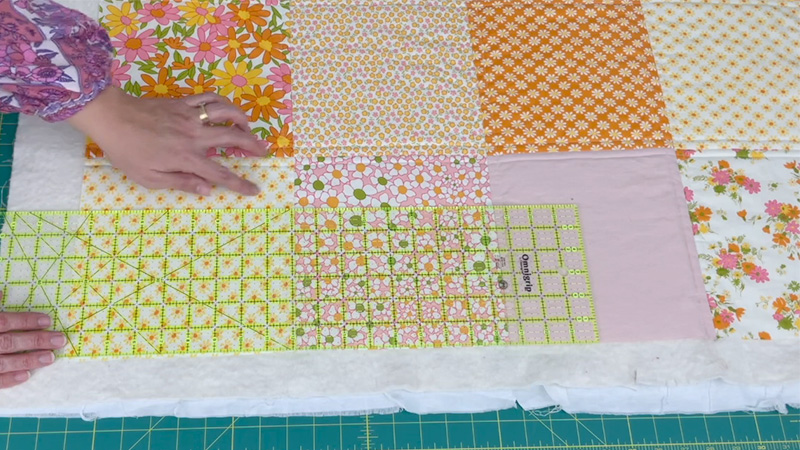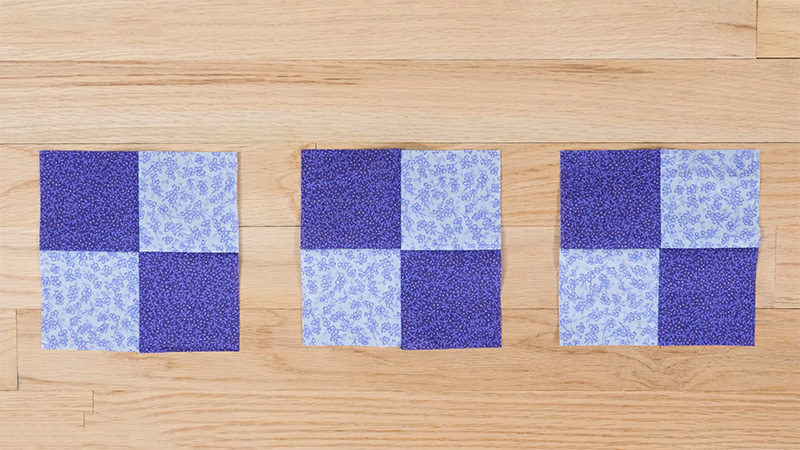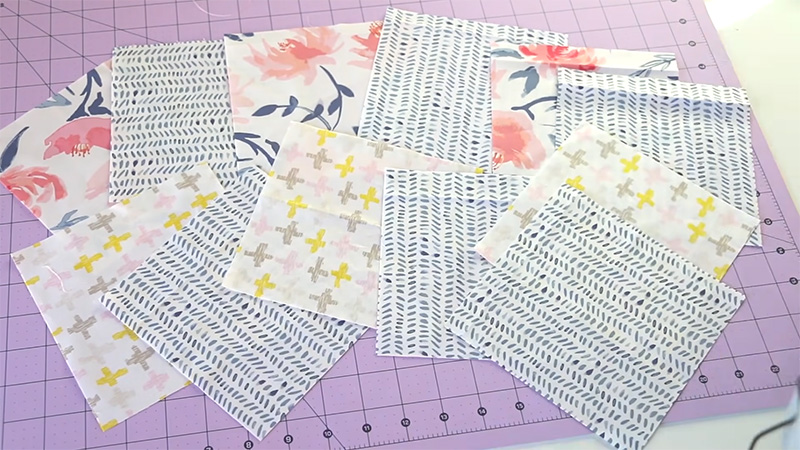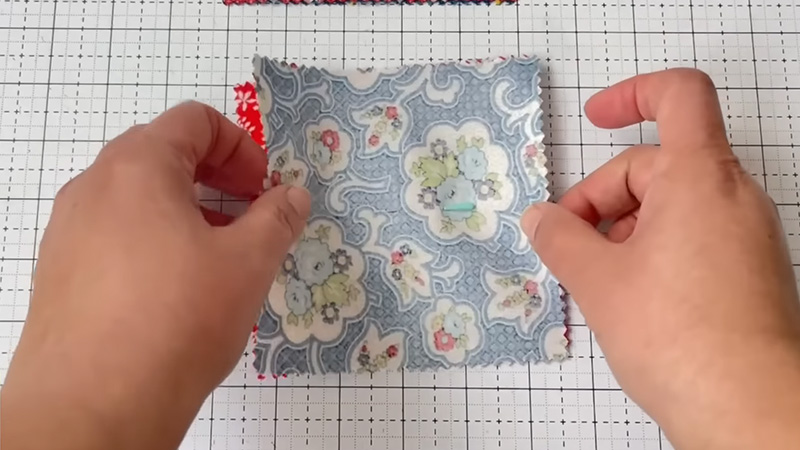Quilting, an art that beautifully weaves together creativity and precision, culminates in the assembly of a quilt top. One of the critical steps in this process is ensuring that the quilt top is perfectly squared.
A squared quilt top is not just visually appealing but also crucial for achieving a professional finish in your quilting project. It ensures that your corners meet at right angles and the edges are straight, creating a harmonious and polished appearance.
In this comprehensive guide, we will explore How to Square a Quilt Top to square a quilt top effectively. From measuring and cutting methods to the use of specialized quilting rulers and creative design choices, we will delve into the seven simple methods that will empower you to master the art of squaring your quilt top.
Whether you’re a seasoned quilter or embarking on your first quilting adventure, these insights will prove invaluable in elevating the quality of your quilt-making endeavors.

How To Square A Quilt Top?
Squaring a quilt top is an essential step in the quilting process to ensure your finished quilt looks neat and professional. Here are the simple methods:
Measuring and Cutting Method
Lay your quilt top on a flat, clean surface. Use a measuring tape to check the width and length, making sure they are equal. If they’re not, trim the excess fabric to create straight edges.
Ensure your corners form right angles by measuring diagonally from corner to corner; both measurements should be equal.
Cross-Measure Method
Find the midpoint of your quilt’s top edges by folding it in half and marking the center. Then, measure from corner to corner in an “X” pattern, making sure the measurements are equal. Adjust the fabric as needed to achieve symmetry and straight edges.
Square Ruler Method
Place a large square quilting ruler on your quilt top, aligning the ruler’s edges with the quilt’s edges. Use the ruler to trim any excess fabric, following its straight lines. Ensure the corners are square by checking with a right-angle ruler or by measuring diagonally.
Iron and Steam Method
If your quilt top has minor waves or distortions, use an iron with steam to gently press and straighten the fabric. Start from the center and work your way to the edges, using a pressing cloth to protect the fabric. The heat and steam will help the quilt top relax into a more square shape.
Basting Method
Before quilting, you can baste the layers of your quilt (top, batting, and backing) together using temporary basting spray or pins. Basting helps keep the layers aligned, making it easier to square up the quilt top later in the process.
Blocking Method
For more significant distortion, consider blocking your quilt top. Wet the fabric gently and then pin it to a flat surface, stretching it to the desired dimensions. Allow it to dry completely, and the quilt top should square up nicely.
Auditory Method
Lay your quilt top flat and tap each corner with your fingers while listening for a consistent sound. If there’s a dull or hollow sound in some areas, it indicates excess fabric. Trim these areas until you hear a uniform, solid sound across the quilt top.
Remember that achieving a perfectly square quilt top may take some patience and practice, especially if your piecing is complex or if the fabric has stretched during construction.
These methods can help you square your quilt top and ensure a polished finished product.
Supplies To Square Up A Quilt

Squaring up a quilt requires a few essential supplies to help you achieve straight edges and right angles. Here are the supplies:
Quilting Ruler
A quilting ruler is a long, rectangular tool with clear markings for measuring and cutting fabric. Look for a square quilting ruler with 90-degree angles for squaring up your quilt.
These rulers often come in various sizes, but a 12.5-inch square or larger is versatile for most quilts.
Rotary Cutter
A rotary cutter is a sharp, circular blade tool that makes clean and precise cuts through the fabric. It pairs perfectly with a quilting ruler to trim excess fabric from the edges of your quilt top, ensuring straight lines and sharp corners.
Cutting Mat
A self-healing cutting mat is a protective surface that allows you to safely use your rotary cutter without damaging your table or workspace. Place it underneath your quilt top when trimming to protect your surfaces and extend the life of your cutter blade.
Measuring Tape
A measuring tape or a long, flexible ruler is essential for measuring the dimensions of your quilt top accurately. It helps you ensure that your quilt is both square and the desired size, as well as checking diagonal measurements for square corners.
Straight Pins
Straight pins are handy for temporarily holding layers of fabric together while you square up your quilt. They can help keep your quilt top, batting, and backing aligned during the trimming process, preventing shifting and distortion.
Iron and Ironing Board
An iron is useful for pressing your quilt top before and after squaring it up. It helps remove wrinkles and creases and can be used in conjunction with steam to relax the fabric, making it easier to work with. An ironing board provides a stable surface for pressing.
Right-Angle Ruler
A right-angle ruler, also known as a square ruler or carpenter’s square, is a tool with a 90-degree angle that can help you verify that your corners are perfectly square. It’s especially helpful when checking your quilt top’s diagonal measurements to ensure they match.
These essential supplies are invaluable for squaring up your quilt, ensuring it looks polished and well-crafted. Having the right tools will make the process more efficient and accurate, resulting in a quilt with clean lines and precise angles.
What Are Some Of The Best Fabrics To Square A Quilt Top?

Selecting the right fabric for your quilt top is crucial for achieving a squared and visually appealing result. Here are some of the best fabrics for squaring a quilt top:
Cotton Fabric
Cotton is one of the most popular and versatile choices for quilt tops. It’s easy to work with, holds its shape well, and is readily available in a wide range of colors and prints.
Cotton fabrics are generally stable and have minimal stretch, making them ideal for achieving straight edges and sharp corners when squaring your quilt top.
Quilting Cotton
Quilting cotton is a subset of cotton fabric specifically designed for quilting. It has a high thread count, which makes it smooth and easy to sew.
Quilting cotton comes in a multitude of colors and patterns, ensuring you can find the perfect fabric for your project while maintaining ease of handling.
Muslin Fabric
Muslin is an unbleached, plain-woven cotton fabric. It’s often used for quilt backings and as a foundation for piecing quilt blocks. While it may seem plain, muslin’s stability and lack of stretch make it a reliable choice for achieving squared edges on your quilt top.
Linen Fabric
Linen is a natural fiber known for its durability and breathability. It can add a rustic or textured look to your quilt top, but it does have a bit more stretch compared to cotton. Be cautious when using linen, and ensure proper stabilization to maintain squareness.
Batik Fabric
Batik fabrics are hand-dyed or printed with intricate patterns, resulting in a unique and vibrant appearance. These fabrics often have a slightly stiffer texture, which can help maintain the shape of your quilt top during the squaring process.
Quilt Backing Fabric
Quilt backing fabrics, typically wide-width cotton, are designed to cover the entire back of the quilt. They tend to be more stable and less prone to stretching, making them an excellent choice for achieving squared edges on the quilt top. You can also use these fabrics on the front of your quilt if you like the design.
Solid-Colored Fabrics
Solid-colored fabrics, whether cotton or other suitable materials, can be advantageous for achieving a crisp, squared look.
Solids provide a clean canvas, allowing any piecing or quilting designs to stand out, and their consistent color can make any imperfections in squaring more noticeable.
When selecting fabrics for your quilt top, it’s essential to consider the stability, stretch, and quality of the material. While these seven options are among the best for achieving squared edges, personal preference and the specific design of your quilt will also play a role in your fabric choice.
Trending Patterns To Square A Quilt Top

Quilt patterns can significantly impact the overall appearance of your quilt top. Here are the trending quilt patterns for squaring a quilt top:
Modern Geometric Patterns
Modern quilting has gained popularity in recent years, with bold geometric designs at the forefront. Patterns like chevrons, triangles, and hexagons create visually striking quilt tops that can be squared up easily due to the clean lines and straight edges inherent in geometric shapes.
Log Cabin Quilts
The timeless log cabin pattern remains a trendsetter in the quilting world. Its symmetrical blocks, which consist of strips radiating from a center square, result in a quilt top with naturally squared edges. Modern variations incorporate fresh color schemes and layouts.
Half-Square Triangle Quilts
Half-square triangles are a versatile element in quilting. Their inherent triangular shape makes it easy to create sharp corners and straight lines when assembling the blocks. This pattern can be adapted in countless ways to suit your style.
Rainbow and Ombre Quilts
Quilts featuring rainbow color schemes or ombre gradients are on-trend, providing a vibrant and visually appealing look. These quilts often use simple patterns like squares or rectangles, making it relatively straightforward to square up the quilt top.
Improvisational Piecing
The trend of improvisational quilting embraces freeform piecing and asymmetry. While it may seem unconventional, these quilts often use straight-line quilting to emphasize the design, and the squared edges can be achieved through careful trimming after the quilt top is assembled.
Scrap Quilts
Quilters continue to embrace scrap quilts as a sustainable and visually intriguing choice. While these quilts may appear scrappy, the use of consistent block sizes and uniform seam allowances helps maintain squared edges when assembling the top.
Modern Minimalism
Minimalist quilts focus on simplicity, often with large blocks of solid color or minimalistic designs. The clean lines and straightforward layouts make it easier to square up the quilt top. Minimalism allows for bold, high-contrast quilts that stand out.
These trending quilt patterns offer a range of design possibilities while still allowing for squared quilt tops. Keep in mind that your choice of fabric, color palette, and personal creativity will influence the final look.
FAQs
Why is it essential to square a quilt top?
Squaring a quilt top is crucial for achieving a polished and professional finish. It ensures that your quilt’s edges are straight, corners meet at right angles, and the overall appearance is visually appealing.
A squared quilt top makes the quilting process smoother, resulting in a well-crafted final product that lays flat and looks impeccable.
Can I square a quilt top without special tools?
While specialized tools like quilting rulers and rotary cutters are helpful, you can square a quilt top without them. Basic measuring and cutting methods, such as measuring diagonals and trimming excess fabric, can be done with a measuring tape and scissors. However, using quilting tools can enhance precision and ease the process.
How do I square a quilt top with irregular shapes or blocks?
Squaring irregular quilt tops can be challenging, but it’s achievable. Focus on squaring each block individually, ensuring they have straight edges and right angles.
Then, sew the blocks together, paying attention to aligning seams and corners. Gradually trim any excess fabric to achieve a squared overall quilt top.
What if my quilt top stretches or distorts during the quilting process?
Answer: To prevent stretching, always handle your quilt top gently and use quilting pins or basting to secure layers. If stretching occurs, consider blocking the quilt top by wetting it and gently stretching it back into shape, then allowing it to dry flat. Alternatively, use steam and an iron to relax the fabric and reshape it.
How do I check if my quilt top is perfectly squared?
To ensure your quilt top is squared, measure the width and length to confirm they are equal. Check the diagonals by measuring from corner to corner; both diagonals should be the same length.
Use a right-angle ruler to verify that corners form 90-degree angles. If necessary, make small adjustments by trimming excess fabric until your quilt top meets these criteria for a squared finish.
Conclusion
Squaring a quilt top may seem like a meticulous task, but it’s a fundamental skill that can make a world of difference in the final presentation of your quilts. A perfectly squared quilt top not only enhances the aesthetic appeal but also reflects the dedication and craftsmanship you’ve poured into your project.
Throughout this guide, we’ve explored seven effective methods to square a quilt top, each offering unique advantages and tailored to different quilting preferences.
Whether you opt for the precision of quilting rulers, the versatility of cotton fabrics, or the trendiness of modern patterns, these techniques empower you to create quilts that stand out for their symmetry and professional finish.
As you continue your quilting journey, remember that practice and patience are your allies.
Over time, squaring a quilt top will become second nature, and the satisfaction of presenting a perfectly squared quilt will be a testament to your quilting expertise and passion.
Leave a Reply